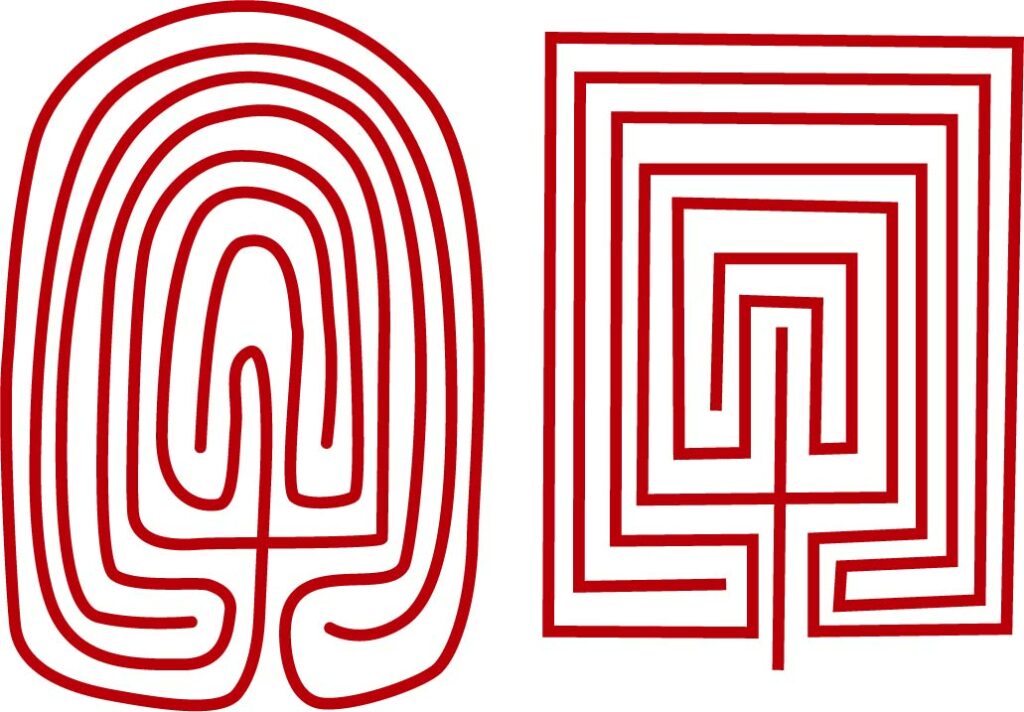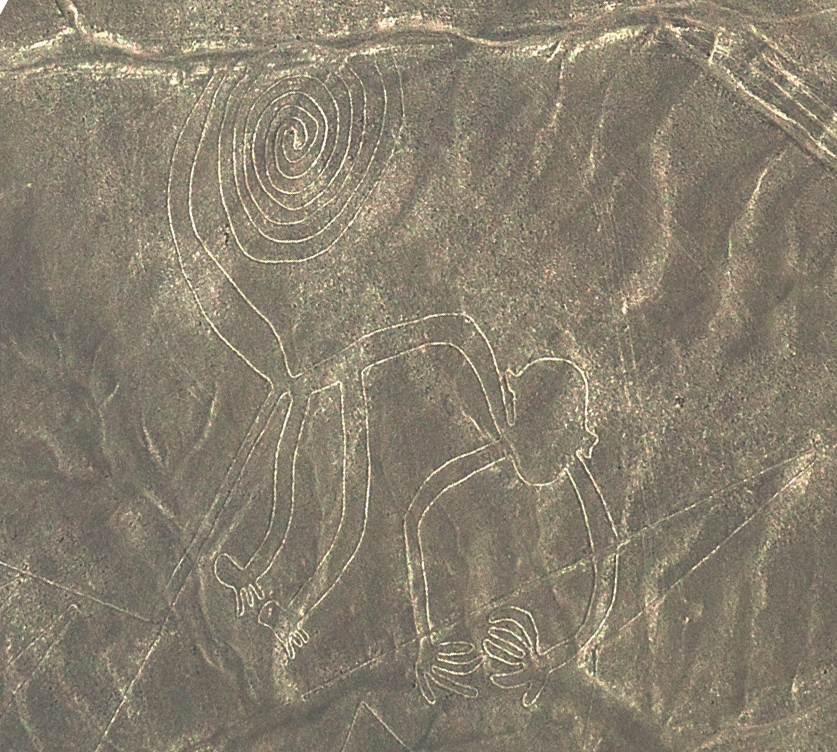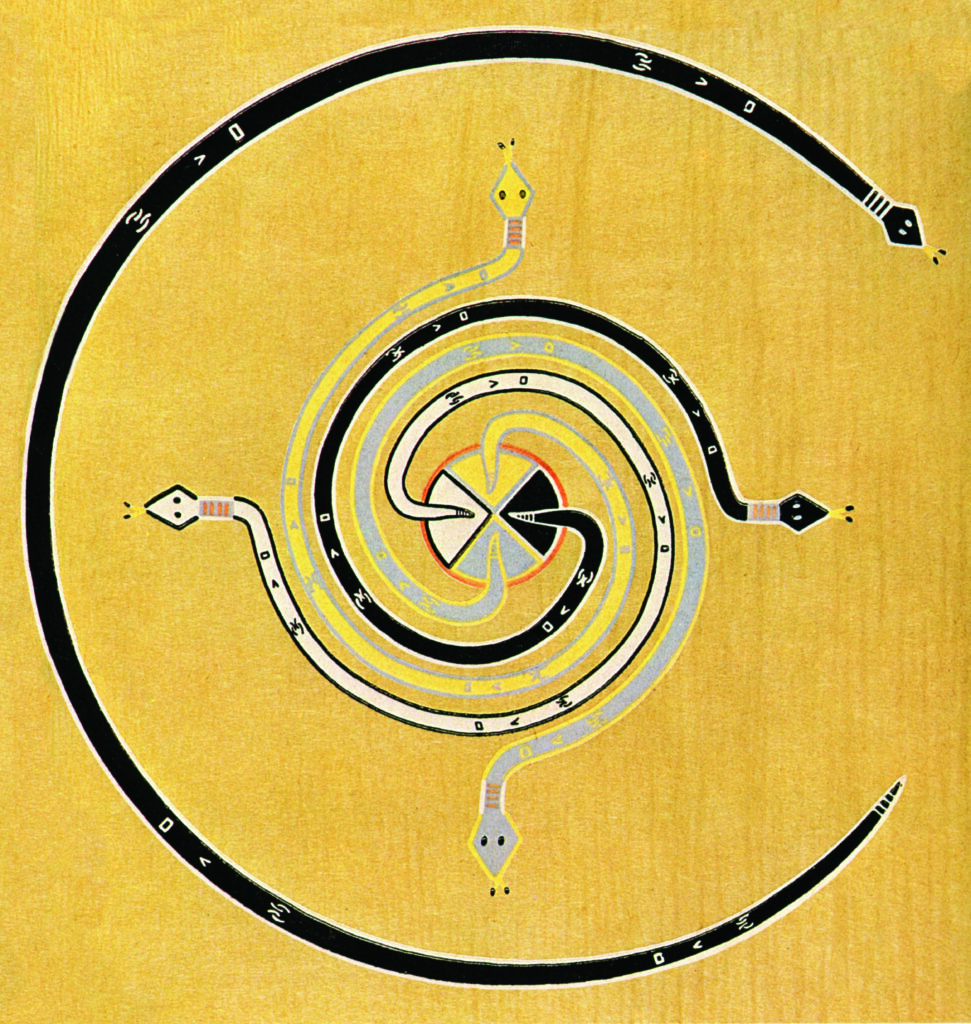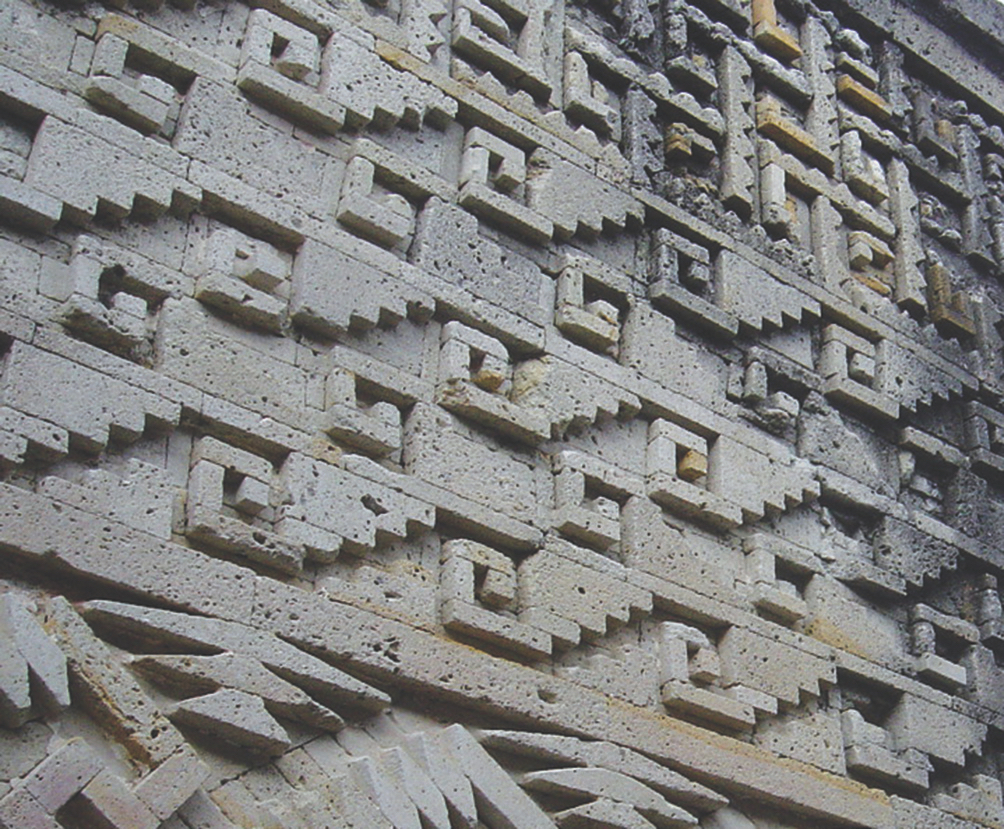In my illustrated talk on ‘The Curious History of Labyrinths & Mazes’, I cover the highlights of this fascinating four-thousand year story. After a recent talk in Cambridge, a member of the audience asked specifically about labyrinths and mazes in the Americas, which is the focus of this post, drawn from a 2018 article I wrote for the website, Mexicolore.
Mysterious origins
The labyrinth design occurs worldwide during prehistoric times, when travel between the continents would have been virtually non-existent, which simply adds to the mystery. It suggests that humans as a race have always been intrigued by the pattern, preoccupied with spirals, circuitous routes, and their associated rituals. Knowledge of the original purpose of these rituals in specific cultures has not always travelled as effectively over time as the design itself, and from today’s perspective we can only surmise the true meaning in some cases. Labyrinths do, of course, occur in nature and must surely have inspired humans to create labyrinthine symbols. The Greek word for the Nautilus shell, for example, is laburinthoi.
The earliest recorded labyrinths created by humans are found in petroglyphs, ancient rock carvings. Dating these precisely is challenging, and identifying the very first carved labyrinth is tricky, if not impossible. A disputed contender for the earliest is an incision on an inner chamber wall of the Neolithic tomb known as Tomba del Labrinto at Luzzanas in Sardinia; some experts however, have concluded this may actually be Roman. Most intriguing are the early labyrinths of North America.
As Jeff Saward (co-founder of Labyrinthos) declares, the origin of labyrinths in the American Southwest is one of the biggest mysteries of the entire story. Examples are found in southern Arizona, near the Gillespie Dam, and in New Mexico at Arroyo Hondo and Galisteo, but so far, no inscription or decoration has been found on a securely datable object from pre-European times. In the 1930s and ’40s, former Arizona Senator William Coxon recorded labyrinth petroglyphs in the Southwest and devised the theory that these geometric inscriptions, found in very widely separated localities, provided evidence of global migration. Saward calls for further fieldwork and the cataloguing of labyrinth petroglyphs, so we may determine exactly how and when the labyrinth reached the New World.
Meaning and mythology in the Americas
In the Americas the labyrinth can be a symbol of tribal identity. The Man in the Maze design, for example, features in Tohono O’odham and Pima legends. The Salt River Pima-Maricopa Indian Community adopted the Man in the Maze motif as their Great Seal. In this context, the design symbolizes an elder brother or medicine man, living in a place where people could not find him.

Mazes and labyrinths clearly refuse to conform to any rudimentary definition, and in attempting to navigate their winding history, I devised broadly chronological classifications; ‘classical’, ‘spiritual’, ‘medieval’, ‘rustic’, ‘romantic’ and ‘modern’. In many cultures, labyrinths have been given a metaphysical or sacred status that takes us beyond the natural world, as ritualized symbols and sites with different devotional purposes. And it is this that I specifically refer to the Mesoamerican notion of mazes.
Perhaps the most illuminating way of tracing the real origins of the labyrinth (or maze – I use the term interchangeably) is indeed to investigate its deeper significance. As I’ve already acknowledged, the form is integral to cultures worldwide. In the book I explore historical icons in different locations, along with associated practices and what they signify, particularly from a symbolic and spiritual perspective. By engaging with labyrinths and mazes in a spiritual context, we give meaning to their many and various interpretations. These include a metaphor for life’s journey, a means of warding off evil, a method of ensuring fertility, and a form of spiritual devotion.
The mythology of the Hopi of northern Arizona features labyrinths. Most well-known is the Tapu’at, the “Mother and Child” symbol. Both the circular and square forms represent the womb of Mother Earth, the divine birth-giver. The circular in particular is said to represent the road of a human life. In following it, one attains spiritual rebirth. From early on, the labyrinth has been associated with death and rebirth. In death, one returns to the earth (the eternal mother), from which one is reborn. The Tohono O’odham and the Pima peoples employ the labyrinth design extensively in their craftwork.

Mazes and labyrinths are symbols of all that is experienced in life, depicting the choices we have to make along our journey. For some American indigenous peoples, the centre of the labyrinth exists simultaneously in this world and in the spiritual world, providing us with a doorway to a different dimension of reality. A saying in North America for example, tells us, ‘To die is to walk the path of the dream without returning.’ In some cultures, mazes were used to keep the dead from returning. In 1955 the French anthropologist Claude Levi-Strauss wrote in Tristes Tropiques about fragments of Tupi pottery urns in Brazil, with a design that represented a maze intended to confuse the evil spirits looking for the human remains preserved in them.
‘The lacy black markings seemed to form a labyrinth—destined, so people say, to deter those evil spirits which would otherwise have sought out the bones that were once preserved in these urns.’
Kindred spirits across time and continents
In some Mesoamerican cultures it was believed that the wicked could be ‘mazed’ in the underworld, so their souls would not return. The notion of spirits being ‘mazed’ is an interesting one in the context of this history. It gives an indication of where we may tentatively link ancient practices in Mesoamerica to other aspects of the global narrative. For example, the word ‘maze’ itself, like its companion, has multiple derivations. The Roman poet Virgil brings them together in The Aeneid and describes the labyrinth as having, ‘a path woven with blind walks.’ It is a,
‘bewildering work of craft with a thousand ways where the tokens of the course were confused by the indiscoverable and irretraceable maze.’
Here we have ambiguity, confusion, uncertain choices, and the search for a clear path. Much later, in Geoffrey Chaucer’s Canterbury Tales, we find examples of early English usage that also combine these themes. People are in a state of “masednesse.” That is, they are puzzled or bewildered.
In my book, The Curious History of Mazes, I cover the topic of mazes as puzzles, from early medieval artefacts to the modern maze revival. That revival was (and still is) realized in the hands of extraordinary individual innovators who garnered not only their incredibly creative and inventive minds but also a vast range of tools and materials, taking the design and construction of mazes to levels of multidimensional complexity never previously imagined. Today there are many companies and maze-makers world-wide who create and construct mazes of all kinds. It is big business.
I also compare the maze and labyrinth experience, acknowledging that some will insist that a maze is a puzzle and a labyrinth is not. However, as W.H. Matthews declares in his most comprehensive 1922 history of labyrinths and mazes, the labyrinth itself represents the enigmatic character of life. This is the intriguing – and puzzling – essence of labyrinths and their mythology. Sig Lonegren, founding member of The Labyrinth Society, writes in 1991 that while a myth is not history, it can point to truths far beyond historical fact. I couldn’t agree more. He says that,
‘each teller adds part of his or her own essence to the tale. Sometimes cultures, for purposes of their own, change significant portions of a given myth; however, the essential bones of the story seem to carry through the many tellings and revisions.’
The essential bones of this story, certainly where ancient American cultures are concerned, do seem to be spiritual, although it appears the creator(s) was not always aiming to confuse. Take the enigmatic series of geoglyphs, the Nazca lines, covering nearly 400 square miles (1,036 sq km) of the Peruvian desert. Discovered by archaeologist Toribio Mejía Xesspe in the 1920s, these lines were drawn by the Nazca people, a civilization that disappeared almost 1,500 years ago, living in what is now modern Peru.
Designated a UNESCO world heritage site in 1994, they were originally created by the scraping away of red dust and rock to reveal the white ground beneath. Many of the designs are geometric shapes or resemble animals including monkeys, humans, birds, and fish. In 2012 a team of British experts declared that they were created to be walked. Well preserved, they were probably walked by small groups of people in single file, indicating that they had a spiritual purpose.

In North America, the Navajo peoples sand painted mandalas were created for ritual healing. Each sacred painting was made communally by several artists who started from the centre and worked outward, following the sun from the east, through south and west, to finish in the north. The eastern side of the circle is left open to allow spiritual beings to enter. Every painting is unique, and like the monks of Tibet, the Navajo used the sand paintings not to confuse but to restore order and harmony. They are still created today.

Reichard and F. J. Newcombe, 1937
And finally, we find the labyrinth-like meander design featured in South American art and architecture. For example, the xicalcoliuhqui, known as a “step” or “stepped” fret—greca in Spanish—is a common motif in Mesoamerican art. It consists of three or more steps connected to a hook or spiral. The motif appears on temples and other sacred buildings such as the Pyramid of the Niches at the Veracruz site of El Tajin.

The few examples I’ve featured here suggest that the aim of labyrinths and mazes in the Americas was not always to confuse, but also to harmonize and enlighten. In writing The Curious History of Mazes I certainly aimed to do the latter, by introducing a complex history to a wide audience, citing thoughts and theories while echoing the prevailing mysteries.

The Curious History of Mazes by Julie E. Bounford, is illustrated by Trevor Bounford and published by Wellfleet Press, October 2018, price £12.99 ISBN: 978-1-57715-177-7
If you would like to book an illustrated talk on ‘The Curious History of Labyrinths & Mazes’, do email:
